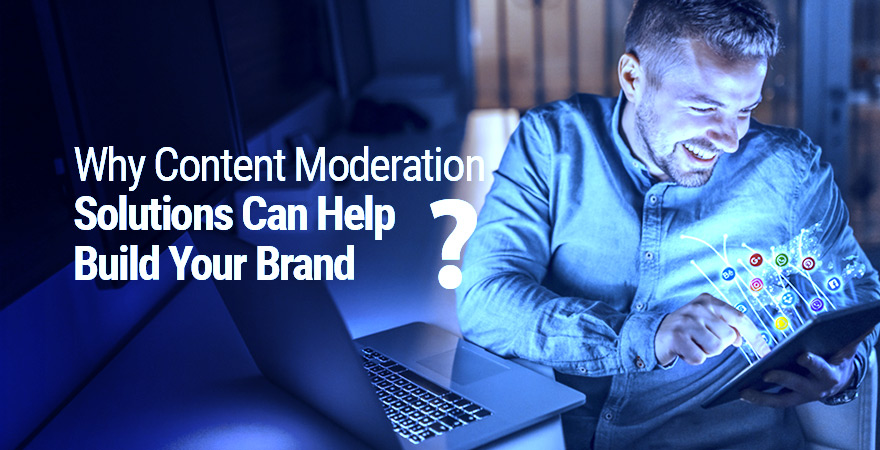The digital new age has brought millions of people various methods of open communication in the primary form of social websites and applications. These also serve as the medium of interaction between the provider and the customer. Where User Generated Content can help build your brand image, any unwanted materials that may find their way to your social sites may prove extremely harmful. User-generated content is any content shared by the end-user that may be reflective of commentary, opinion, sentiment, promotion, or criticism of said service or product. This is where Content Moderation Solutions come into play for an overall positive experience.
The Content Moderations Solutions market is set to grow at a CAGR 8.5% from 9.8 Bn USD in 2020 to 26 Bn USD in 2030. – KSU Sentinel Newspaper

Online engagement of consumers not only draws attention to your brand but also helps with referrals. If any company wants to expand its digital footprint, then user interaction is a necessity; as is used as a marketing tactic by many enterprises.
What is Content Moderation?
Content Moderation refers to the practice of scanning, identifying, filtering, and/or removing content that may not be in line with community regulations or permissible by a company’s internal voice. This practice usually pertains to online content generated by users and the public on a company’s social pages or websites. Based on pre-determined rules, the content shared on any social site is screened for appropriateness and authenticity before being distributed among general viewers.
The Roles and Responsibilities of a Content Moderator
Acting as a peacekeeper, a guardian to your company’s reputation, and as a communication channel between the audience and the service provider; moderators have a lot riding on their shoulders. The role requires decision-making prowess due to its nature of timely assessment of potentially problematic situations. A content moderator needs to possess constant vigilance, patience, and level-headedness to smartly deal with any crisis online. The responsibilities of a content moderator include but are not limited to:
Maintaining company voice and PR online, ensuring relevance to niche
Analyzing context and emotion to mitigate digital wildfires
Keeping a safe and healthy sharing environment for all
Identifying and filtering trolling, hate speech, scams, illegal content, or fraudulent activity
Sifting through UGC images, text, comments, postings, videos, to ensure all content is in line with forum rules
Communicating with audiences for queries and complaints
Engaging customers towards the brand
Providing social media support for all the above.
Only human involvement allows you to read between the lines, which is something often missed by technology, though automatic handling reduces the workload on moderators by almost half.
Why is Content Moderation Important for Your Brand?
On the internet, everyone has an opinion and a free voice, which may sometimes be used negatively. Your social sites should present a safe, clean, on-brand experience to anyone who visits them. In order to keep inappropriate, offensive, or irrelevant content off your social pages, moderation is necessary.
There are 3.96 billion social media users worldwide in 2021 – broadbandsearch.net
Sometimes unmonitored conversations may lead to digital wildfires that spread faster than you can mitigate them, causing long-term harm to your company image. User experience is highly valued in today’s no-contact mobile purchasing world and heavily relied upon for decision-making. Customers write about how your service or product makes them feel, which can either inspire others to follow suit or redirect them somewhere else.
Customer experience will take over as a key differentiator for brands by 2021 – superoffice.com
According to a UGC stats study at tintup.com, 93% of customers consider user-generated content before purchasing a product.
Customer Experience is key to Customer Loyalty. Nowadays, companies use influencers to drive more consumers towards their services because it provides a more personalized touch. Positive word of mouth is a powerful tool that resonates with buyer sentiments. In the same way, negative comments can be detrimental to your brand value with a single bad user experience.
Benefits and Risks of Utilizing Content Moderation
There are some general risks associated with not monitoring what is shared on your social platforms. Content is king and there is proper netiquette to keep in mind when anything is shared on the internet, which sometimes needs defined boundaries and regulation checks. Here are some benefits versus risks of using content moderation for your consideration:
| Benefits of Using Content Moderation | Risks of Not Using Content Moderation |
|---|---|
| Protects users from harmful content and unwanted experiences creating a healthy interactive environmen | Illegal content sharing may lead to legal implications |
| Helps build trust and recognition of your brand among users | Vulnerability to threats, scams, rumors, hate speech, attacks, and propaganda |
| Expands your audience through influencer marketing | Content shared may not be authentic or verified and may damage company image regarding quality |
| Increases your engagement, traffic, and conversion | Context may be missed in conversation leading to misunderstanding and digital wildfires |
| Provides you better insight of customer behavior, user analytics, and consumer needs | Irrelevant content or third-party marketing may flood your social pages, causing loss of viewership |
| Helps keep a consistent company voice | Real-time publishing can be damaging to repute if not monitored |
| Keeps you updated on the latest market trends | People may post something offensive, that could be political, religious, derogatory, obscene, or violent in nature. |
| Provides a 24/7 overview of activity |
Types of Content Moderation Services

Content can be anything from text, video, images on social media, websites, and community forums, etc. People expressing their opinions through shared content may sometimes lead to misinformation or disinformation; the latter more dangerous than the former, as it implies intent. Since a company’s credibility is on the line, moderators have multiple aspects to consider before filtering out any piece of irrelevant information. This is why it is necessary to know the different types of content moderation available, to identify what suits your service requirements. Taking the example of social media content moderation, we can consider the following:
Pre-Moderation
Provides proactive control of content before it even reaches platforms. A moderator has to preview all comments, images, and shared materials to approve or reject according to set guidelines. It effectively handles issues before they even arise, but the downside is that it may reduce user engagement in real-time, caused by delays in approval.
Post-Moderation
Happening in real-time, this type of moderation is applied after content is visible and only when required. It allows users to interact live. It can also help moderators access the situation to add, edit, or remove any piece of content only when it crosses guidelines. Beneficial for audience engagement and involvement on your social platforms.
Reactive Moderation
This type is dependent upon users (especially the social media community) to flag any materials they may deem inappropriate, harmful, or abusive through report buttons placed within social sites. The administrator will then review the marked post to verify the alert and remove or keep it as per the rules of the site owner. The advantage is that any potential problem is immediately addressed as flagging makes it easier to identify, while the risk is that there is lesser control over what is shared. A piece of content would remain online until it is reported by someone to be removed.
Distributed Moderation
A lesser-known and used form of moderation, distributed moderation leaves the identification of unwanted content up to the decision-making power of the community. By scoring or voting on a piece of content the users decide which content falls under regulations or not. It can be an interactive way to access your audience’s involvement with your platform, but can also expose you to harm; particularly when you have no control over the material shared.
Automatic Moderation
Utilizing technology and software to automatically detect offensive words, images, or content, automated moderation uses a pre-determined list of filters to identify what to keep or remove. Using UGC tools to determine the health of any post; these filters have to be constantly updated to make them accurate with time. It is a faster and simpler solution for companies with a lot of social engagement but requires human intervention to filter out undesirable content based on extreme sentiment or hidden context.
.
Some other types include AI moderation, User-Only Moderation, and No moderation; The first utilizes automatic tools to filter content that does not meet a set of requirements through AI, making it user-friendly, though lacking in emotional context analysis. The second automatically hides content that is reported by the audience time and again; it is cost-effective but implies that your users have been exposed to adverse material several times. The last is only a viable option if you have very limited social engagement and are not worrisome about what is contributed to your social platforms; but in today’s day and age, is not advisable to leave any digital platform completely unattended.
Conclusion
Content Moderation allows organizations to provide a safe and healthy environment on their digital platforms where people can interact openly and share subject-relevant content. It helps you map a Customer’s entire journey; understanding what your strengths are and what needs to be worked upon. Not applying moderation means you have no check and balance to how you are represented online, which is not recommended for any business. If you require assistance for Content Moderation Services, then contact us for further assistance and free consultation; or visit Premier’s website for more information on how we can help.
 Skip to content
Skip to content





